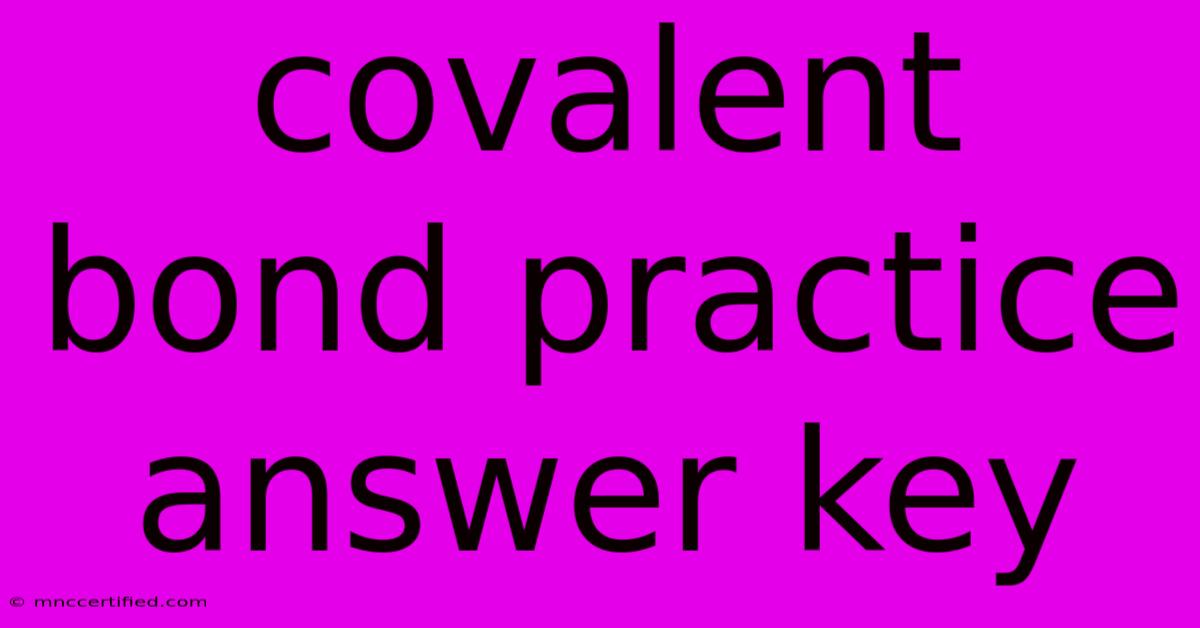Covalent Bond Practice Answer Key

Table of Contents
Covalent Bond Practice: Answers and Explanations to Master Chemical Bonding
Understanding covalent bonds is crucial for mastering chemistry. This comprehensive guide provides answers and detailed explanations to common covalent bond practice problems, helping you solidify your understanding of this fundamental concept. We'll cover various aspects, from identifying covalent bonds to predicting molecular shapes and polarities. This isn't just an answer key; it's a learning tool to boost your chemistry skills.
What is a Covalent Bond?
Before diving into the practice problems, let's refresh our understanding. A covalent bond is a chemical bond formed when two atoms share one or more pairs of electrons. This sharing allows both atoms to achieve a more stable electron configuration, often resembling a noble gas. This contrasts with ionic bonds, where electrons are transferred from one atom to another. Covalent bonds typically occur between nonmetal atoms.
Covalent Bond Practice Problems: Answers and Explanations
Let's tackle some common practice problems. Remember, understanding the why behind the answer is as important as getting the correct answer itself.
Problem 1: Identify which of the following pairs of atoms are most likely to form a covalent bond:
a) Sodium (Na) and Chlorine (Cl) b) Carbon (C) and Oxygen (O) c) Magnesium (Mg) and Oxygen (O)
Answer: b) Carbon (C) and Oxygen (O)
Explanation: Sodium (Na) and Chlorine (Cl) form an ionic bond because sodium is a metal and chlorine is a nonmetal. Magnesium (Mg) and Oxygen (O) also form an ionic bond for the same reason. Carbon and Oxygen, both nonmetals, are more likely to share electrons, forming a covalent bond.
Problem 2: Draw the Lewis structure for water (H₂O).
Answer:
O
/ \
H H
Explanation: Oxygen has six valence electrons, while each hydrogen has one. Oxygen needs two more electrons to complete its octet, and each hydrogen needs one. By sharing electrons with two hydrogen atoms, oxygen achieves a full outer shell.
Problem 3: Predict the molecular geometry of methane (CH₄).
Answer: Tetrahedral
Explanation: Carbon is the central atom with four bonding pairs of electrons (one each to four hydrogens). VSEPR theory predicts a tetrahedral geometry to minimize electron repulsion.
Problem 4: Determine the polarity of the carbon monoxide (CO) molecule.
Answer: Polar
Explanation: Although both atoms are nonmetals, oxygen is significantly more electronegative than carbon. This difference in electronegativity creates a dipole moment, resulting in a polar molecule. The electrons are pulled more towards the oxygen atom.
Problem 5: Which of the following molecules exhibits resonance?
a) Methane (CH₄) b) Ozone (O₃) c) Carbon Dioxide (CO₂)
Answer: b) Ozone (O₃) and c) Carbon Dioxide (CO₂)
Explanation: Resonance occurs when a molecule can be represented by multiple Lewis structures that differ only in the placement of electrons. Both ozone and carbon dioxide can be drawn with different locations for double bonds, resulting in resonance structures. Methane has a single, clear Lewis structure.
Advanced Covalent Bonding Concepts:
To further enhance your understanding, consider exploring these advanced concepts:
- Multiple Bonds: Double and triple bonds involving the sharing of two or three pairs of electrons.
- Coordinate Covalent Bonds: A covalent bond where both electrons in the shared pair come from the same atom.
- Polarity and Intermolecular Forces: How the polarity of molecules affects their interactions with other molecules.
- VSEPR Theory: A model used to predict the shapes of molecules based on electron repulsion.
- Hybridization: The mixing of atomic orbitals to form hybrid orbitals with different shapes and energies.
Off-Page SEO Strategies for Enhanced Visibility
To improve your article's search engine ranking, consider implementing the following off-page SEO techniques:
- High-Quality Backlinks: Earn links from reputable chemistry websites and educational resources.
- Social Media Promotion: Share your article on relevant social media platforms.
- Community Engagement: Participate in online chemistry forums and discussions.
By consistently practicing problems and understanding the underlying concepts, you will significantly improve your comprehension of covalent bonds and achieve better results in your chemistry studies. Remember, consistent effort and application are key to mastering this important topic.

Thank you for visiting our website wich cover about Covalent Bond Practice Answer Key. We hope the information provided has been useful to you. Feel free to contact us if you have any questions or need further assistance. See you next time and dont miss to bookmark.
Featured Posts
-
Trc Capital Investment Corporation
Nov 17, 2024
-
Night Guard Cost Without Insurance
Nov 17, 2024
-
Hoosier Country 105 1 Trading Post
Nov 17, 2024
-
Watch Alabama Vs Mercer Live Stream
Nov 17, 2024
-
New Miss Universe Minute By Minute
Nov 17, 2024